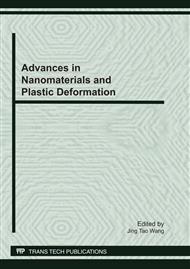p.131
p.139
p.145
p.153
p.159
p.167
p.171
p.177
p.185
Numerical and Experimental Investigation of Strain Inhomogeneity during Cyclic Channel Die Compression
Abstract:
Severe plastic deformation (SPD) can refine conventional coarse-grained materials to submicrometer or even nanometer level. In this paper, effective strain distribution was simulated by rigid-plastic finite element method (FEM) after multi-pass cyclic channel die compression (CCDC) by two different processing routes, and the Vickers microhardness was examined to verify the deformation distribution. The results show that large strain can be accumulated in the material by CCDC. The deformation distribution is non-uniform. Apart from the edges or corners of the specimen, the effective strain is higher in the central region and lower at the surrounding region. The effective strain gradient increases with the number of compression. The microhardness distribution features of two routes are in agreement with the simulation results of strain distribution. The microhardness increases globally with the number of compression and its distribution is inhomogeneous at the small and medium strain stage. But with the increasing of strain, the microhardness homogeneity is improved.
Info:
Periodical:
Pages:
159-165
Citation:
Online since:
March 2011
Authors:
Price:
Сopyright:
© 2011 Trans Tech Publications Ltd. All Rights Reserved
Share:
Citation:


